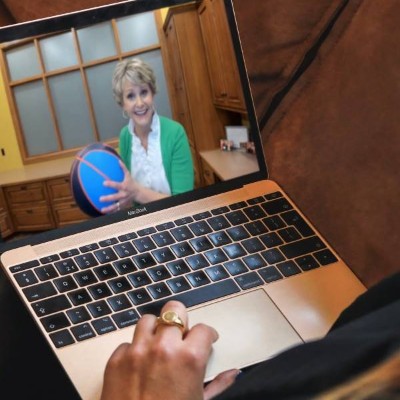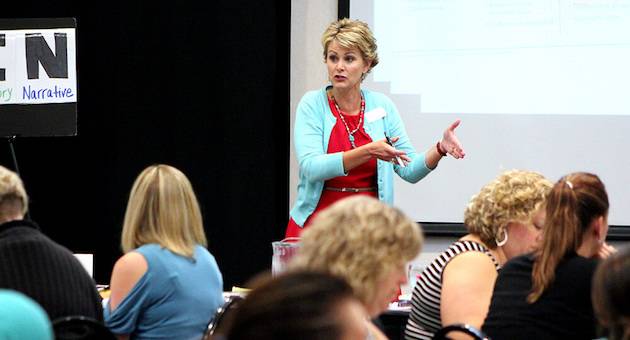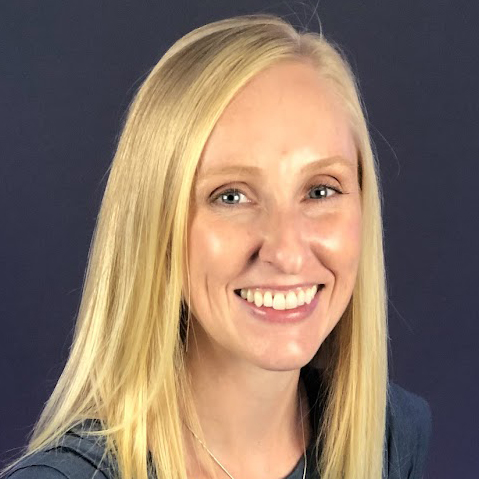15 Ways to achieve buy-in with teacher professional development
by Michelle Schweikhardt
Teacher buy-in is important for sustaining change
Full teacher buy-in creates a solid foundation for the successful implementation of professional development ideas and practices. Each teacher acts as a brick, contributing to a strong and lasting foundation for the initiative. This lays the groundwork for sustainable improvement.

As a leader, it’s tempting to rely on mandates to ensure teacher participation in professional development. However, focusing on teacher participation in professional development as the sole measure of success can cause leaders to overlook essential factors for sustained change. While participation in professional development is a positive step, it doesn’t automatically lead to staff buy-in or implementation.
For teachers to truly embrace and implement new practices, they need to understand the “why” behind the learning and have a clear path to “how” they can achieve the desired outcomes.
When teachers are invested and engaged, PD empowers them to implement new strategies with confidence. And, while a few teachers participating in professional development can spark change, true transformation requires a school-wide effort.
Strategies for getting teacher buy-in
To take teachers beyond just participating, leaders can use these strategies for getting teacher buy-in with professional development:1. Show trust and respect.
First and foremost, treat teachers like the professionals they are. This means showcasing trust in teachers’ expertise. How leaders explain upcoming changes can impact how teachers react to being told a new initiative is on the horizon.
Frame PD as an opportunity to collaborate, share best practices, and collectively improve student outcomes, not as a reflection of individual shortcomings. Showing trust and respect establishes a norm where teachers feel valued and qualified to contribute their unique perspectives.
2. Strike a balance.
Leaders can achieve buy-in for professional development by striking a balance between introducing new initiatives and respecting existing workloads. By overburdening teachers with too much PD or quick-fire changes, leaders risk creating fatigue and a feeling of futility.
Professional development is most effective as part of a long-term plan. In fact, research from the Wing Institute suggests it takes 2-4 years for new programs to take root in schools and districts.
Therefore, introducing new programs too soon or too often can disrupt the learning process and undermine the effectiveness of both initiatives. Keep the focus on targeted, sustainable programs that build on existing strengths and offer clear benefits for both teachers and students.
3. Address their needs and concerns.
Asking for teachers’ input creates an open line for communication between teachers and leaders. By directly addressing teachers’ needs, leaders can turn participation in professional development from an obligation into a valuable opportunity.
Talk to teachers (even hold focus groups or send out surveys) and visit their classrooms to see what challenges they face or what they wish they knew more about.
Then, build PD around their struggles and connect it to their subjects and students to make it valuable, not just a box to check. Tailoring PD ensures it hits the mark, showing leaders understand and care about teachers’ unique needs.
Educators can use formative assessment to pinpoint knowledge gaps, tailor instruction for differentiation, and support students in achieving mastery.
4. Make it relevant and practical.
Teachers crave PD that hits the ground running. Relevant and practical PD addresses teachers’ needs and challenges through concrete tools and techniques that teachers can apply in their classrooms the next day. Instead of feeling overwhelmed by theory, teachers walk away equipped, ready to tackle classroom challenges and see instant results.
Provide teachers with professional development that offers skills and strategies with ready-made resources to save prep time. This shows that leaders understand the day-to-day demands of teachers and want to take steps to help lessen their burdens.

FREE ON-DEMAND WEBINAR
Advance Beyond Doing Reading to Teaching Reading
Learn what explicit, whole-class comprehension instruction looks like and how to effectively scaffold mini-lessons within the rest of the reading block to honor the gradual release of responsibility.

Earn a completion certificate
60-minute webinar
5. Offer choice and flexibility.
Giving teachers choices offers a sense of agency. Leaders can provide various PD topics and formats (online, in-person, blended) to pique different learning styles. Flexible scheduling options (different times, online) respect busy schedules, showing educators’ time and needs are valued. Choice and flexibility over the duration of a long-term PD plan ensure teachers can choose what resonates with them and their busy schedules.
6. Collaborate with teachers in the planning and implementation of PD.
When leaders move beyond simply asking for needs and instead ask for teachers’ input on the long-term plan, teachers feel a sense of ownership over the PD and its implementation. This makes them more likely to be engaged in the learning process, and that’s when change happens.
Invite teachers to help choose topics, presenters, formats, resources, etc. The one caveat is that leaders still have the responsibility, in collaboration with teachers, to ensure the PD aligns with the school’s overall goals and objectives.
7. Connect PD to school goals and student achievement data.
Data and evidence offer unbiased insights, but their true power lies in revealing progress throughout implementation to sustain teacher buy-in.
Use student work and achievement data as conversation starters to help set school goals. Show how professional development directly connects to school goals and promotes student achievement.
Then, throughout the long-term plan, share concrete data and evidence from the PD initiative that demonstrates how it impacts positive changes in student achievement.
Data-driven PD provides concrete evidence of progress, giving teachers a sense of accomplishment and motivation.
8. Set clear and achievable PD goals.
Teachers, like everyone else, need clear goals and direction to get from point A to point B. While connecting PD to school goals provides direction, it’s equally important to clearly explain those goals and the specific, achievable steps needed to reach them.
Being transparent about goals and expectations helps teachers know what to expect. A simple way to do this without creating extra work is through a school-wide professional development plan.
9. Prioritize and provide ongoing support and coaching.
Do not let the learning stop after professional development. Ongoing support and coaching are key to teacher buy-in.
Offer resources and guidance after workshops to help teachers tackle challenges and integrate new strategies into their daily routines.
Regular modeling, coaching, and feedback loops, where teachers can share their experiences and get personalized advice, boost teachers’ confidence and commitment to implementing new practices.
Technological advancements widen the reach of blended learning, making education more accessible for everyone, including learners in remote areas or those with limited resources. This helps bridge the digital divide and fosters inclusive education.
10. Celebrate successes and recognize achievements.
Sharing wins and recognizing teachers’ importance goes a long way. Publicly acknowledge teachers’ success in implementing new strategies. This shows that leaders value their efforts and dedication, boosting morale and encouraging others to participate in future initiatives. It’s a simple, practical way to generate excitement and buy-in for professional development.
If the budget allows, consider offering incentives like bonuses or additional resources for participating in professional development. In a career where teachers rarely receive compensation for extra work, this is a welcome reward for going the extra mile.
11. Foster a culture of professional learning.
Creating an environment where teachers feel supported and encouraged to learn goes a long way in building staff buy-in. When teachers have opportunities to collaborate, share successes, and learn from each other, they become more invested in the process.
By establishing working norms for participation and interaction, professional learning becomes more efficient and engaging for everyone. With set expectations on how to interact, teachers feel comfortable sharing ideas, respectfully disagreeing, and working towards solutions. This leads to a more positive and productive learning environment.
12. Be patient and persistent.
Teachers juggle a lot already. Implementing new strategies takes time and practice. Be patient with teachers as they navigate new approaches and strategies.
Acknowledge their efforts, answer questions, and provide ongoing support whether it’s through time or resources. Offering grace when teachers have setbacks helps teachers build resilience and perseverance, knowing they can try again without fear of judgment.
Lasting change rarely happens overnight. Pressuring immediate change often leads to resistance and disengagement. Let teachers, within reason, embrace change at their own pace.
13. Invest in high-quality PD.
Teacher buy-in for professional development hinges on its quality. While the cost may be higher initially, quality PD is an investment in your teachers and, ultimately, your students.
Prioritize professional development companies with proven track records and strong reputations. Their consultants need to resonate with teachers. Look for consultants who are relatable, knowledgeable, and responsive to teachers’ needs. Opt for those who offer practical support and avoid unrealistic promises. Choosing consultants who value teachers’ expertise and don’t just provide theoretical answers creates a relationship of respect and trust between teachers and the consultant.
14. Be creative.
Sometimes strategies for getting teacher buy-in neglect to embrace creativity. Leaders have an opportunity to elicit staff buy-in if they think outside of the box.
Design professional development around gamification principles. Use game mechanics like points, badges, and leaderboards to create a more engaging and motivating experience. This encourages participation and friendly competition.
Technology opens doors to innovative learning experiences beyond traditional methods. Use virtual reality experiences to transport teachers into different educational contexts, or develop augmented reality activities that layer additional information into real-world settings. Simulations offer teachers a place to practice new skills in a safe, interactive environment.
Another avenue to explore could be through partnering with local organizations to create immersive learning experiences. Consider field trips, guest speaker sessions, or collaborative projects. Engaging with local experts can broaden teachers’ knowledge base, inspire innovative teaching practices, and foster partnerships that benefit the school community.
15. Offer perks.
Spark participation in professional development by offering tangible rewards like raffles, prizes (teaching-related or just for fun), catered meals, snacks, or new classroom resources. These tokens of appreciation go beyond simply saying “thank you” and provide something concrete that teachers can enjoy or benefit from. Even small gestures can go a long way in boosting morale and buy-in.
When leaders show trust in teachers’ expertise, listen to their needs and offer flexible, practical, fun training, it builds a trusting and encouraging school culture.
Teachers drive change
There’s an underlying theme that resonates through most of these strategies for getting teacher buy-in—empowering teachers as the drivers of their own professional growth.
When leaders show trust in teachers’ expertise, listen to their needs, and offer flexible, practical, fun training, it builds a trusting and encouraging school culture. In this atmosphere, teachers feel valued, confident, and empowered to keep improving their practices for the benefit of their students.
This means that while each strategy can be helpful in itself, the real power lies in understanding how the strategies and best practices work together to support teachers in making a school-wide transformation. Using these strategies holistically is “how” to get teacher buy-in.
Customized training to boost teacher buy-in
Find out how Smekens Education PD encourages teacher buy-in and implementation.
Professional Development Services
TEACHER TRAINING

CUSTOMIZED CONSULTING

BOOKS & RESOURCES



